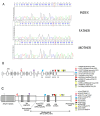A Novel KIDINS220 Pathogenic Variant Associated with the Syndromic Spastic Paraplegia SINO: An Expansion of the Brain Malformation Spectrum and a Literature Review
- PMID: 39336781
- PMCID: PMC11431642
- DOI: 10.3390/genes15091190
A Novel KIDINS220 Pathogenic Variant Associated with the Syndromic Spastic Paraplegia SINO: An Expansion of the Brain Malformation Spectrum and a Literature Review
Abstract
Background/objectives: Identifying novel variants in very rare disease genes can be challenging when patients exhibit a complex phenotype that expands the one described, and we provide such an example here. A few terminal truncating variants in KIDINS220 cause spastic paraplegia (SP), intellectual disability (ID), nystagmus, and obesity (SINO, MIM #617296). Prompted by the result of next-generation sequencing on a patient referred for SP associated with complex brain dysmorphisms, we reviewed the phenotype of SINO patients focusing on their brain malformations, mainly described in prenatal age and first years of life, and tried to understand if the predicted effect of the mutant kidins220 may have caused them.
Methods: We performed whole exome sequencing (WES) and a literature and mutation databases review.
Results: We report a young adult with SP, severe ID, strabismus, and macrocephaly exhibiting brain malformations at follow-up, partially overlapping with those described in TUBB3 tubulinopathy. WES analysis of the proband and parents identified the heterozygous de novo variant (NM_020738.4: c. 4144G > T) p. Glu 1382* in KIDINS220 that was predicted to be causative of SINO.
Conclusions: The progression of myelination and the development of brain structures turned out to be crucial for identifying, at follow-up, the whole KIDINS220-related brain malformations. The truncated proteins associated with SINO lack a portion fundamental for the interaction of kidins220 with tubulins and microtubule-associated proteins. The complexity of the brain malformations displayed by our patient, and possibly by other reported SINO patients, could result from an impaired dynamic modulation of the microtubule cytoskeleton during embryogenesis. Brain malformations must be considered as part of the SINO spectrum phenotype.
Keywords: axon guidance defects; macrocephaly; obesity; scaffold protein; spastic paraplegia; tubulin-related disorders.
Conflict of interest statement
The authors declare no conflicts of interest. The funders had no role in the study design, data collection, analysis, interpretation, manuscript writing, or decision to publish the results.
Figures


References
-
- Higuero A.M., Sánchez-Ruiloba L., Doglio L.E., Portillo F., Abad-Rodríguez J., Dotti C.G., Iglesias T. Kidins220/ARMS modulates the activity of microtubule-regulating proteins and controls neuronal polarity and development. J. Biol. Chem. 2010;285:1343–1357. doi: 10.1074/jbc.M109.024703. - DOI - PMC - PubMed

